Potential Approach for Single-Peak Extinction Fitting of Aerosol Profiles Based on In Situ Measurements for the Improvement of Surface PM2.5 Retrieval from Satellite AOD Product
Abstract
1. Introduction
2. Materials and Methods
2.1. Data Sets
2.1.1. In Situ Measurements
2.1.2. MODIS AOD
2.1.3. GEOS-5 FP PBLH
2.2. Fitting Approach
2.2.1. Log-Normal Distribution
2.2.2. Fitting Procedure for the Single-Peak Extinction Profile
3. Results and Analyses
3.1. Impacts of AOD and PBLH on the Extinction Profile
3.2. Log-Normal Distribution in Terms of the AOD and PBLH
3.3. Scale Adjustment for Seasonal Variation (S)
3.4. Identifying the Height of the Surface Layer
3.5. Validation and Application of a Case Study
4. Discussion
5. Conclusions
Author Contributions
Funding
Acknowledgments
Conflicts of Interest
References
- Akimoto, H. Global air quality and pollution. Science 2003, 302, 1716–1719. [Google Scholar] [CrossRef]
- Pöschl, U. Atmospheric aerosols: Composition, transformation, climate and health effects. Angew. Chem Int. Ed. 2005, 44, 7520–7540. [Google Scholar] [CrossRef] [PubMed]
- Stocker, T.F.; Qin, D.; Plattner, G.-K.; Tignor, M.; Allen, S.K.; Boschung, J.; Nauels, A.; Xia, Y.; Bex, V.; Midgley, P.M. Climate Change 2013: The Physical Science Basis. Contribution of Working Group I to the Fifth Assessment Report of the Intergovernmental Panel on Climate Change; Cambrige University Press: New York, NY, USA, 2013. [Google Scholar] [CrossRef]
- Wu, G.; Li, Z.; Fu, C.; Zhang, X.; Zhang, R.; Zhang, R.; Zhou, D. Advances in studying interactions between aerosols and monsoon in China. Sci. China Earth Sci. 2016, 59, 1–16. [Google Scholar] [CrossRef]
- Caiazzo, F.; Ashok, A.; Waitz, I.A.; Yim, S.H.; Barrett, S.R. Air pollution and early deaths in the United States. Part I: Quantifying the impact of major sectors in 2005. Atmos. Environ. 2013, 79, 198–208. [Google Scholar] [CrossRef]
- Li, C.; Mao, J.; Lau, A.K.; Yuan, Z.; Wang, M.; Liu, X. Application of MODIS satellite products to the air pollution research in Beijing. Sci. China Ser. D Earth Sci. 2005, 48, 209–219. [Google Scholar] [CrossRef]
- Sacks, J.D.; Stanek, L.W.; Luben, T.J.; Johns, D.O.; Buckley, B.J.; Brown, J.S.; Ross, M. Particulate matter–induced health effects: Who is susceptible? Environ. Health Perspect. 2011, 119, 446. [Google Scholar] [CrossRef]
- Owili, P.O.; Lien, W.-H.; Muga, M.A.; Lin, T.-H. The associations between types of ambient PM2.5 and under-five and maternal mortality in Africa. Int. J. Environ. Res. Public Health 2017, 14, 359. [Google Scholar] [CrossRef] [PubMed]
- Lien, W.-H.; Owili, P.O.; Muga, M.A.; Lin, T.-H. Ambient particulate matter exposure and under-five and maternal deaths in Asia. Int. J. Environ. Res. Public Health 2019, 16, 3855. [Google Scholar] [CrossRef]
- Zhang, G.; Rui, X.; Fan, Y. Critical review of methods to estimate PM2. 5 concentrations within specified research region. ISPRS Int. J. Geo Inf. 2018, 7, 368. [Google Scholar] [CrossRef]
- Chu, D.A.; Kaufman, Y.; Zibordi, G.; Chern, J.; Mao, J.; Li, C.; Holben, B. Global monitoring of air pollution over land from the Earth Observing System-Terra Moderate Resolution Imaging Spectroradiometer (MODIS). J. Geophys. Res. Atmos. 2003, 108, 4661. [Google Scholar] [CrossRef]
- Wang, J.; Christopher, S.A. Intercomparison between satellite-derived aerosol optical thickness and PM2.5 mass: Implications for air quality studies. Geophys. Res. Lett. 2003, 30, 2095. [Google Scholar] [CrossRef]
- Engel-Cox, J.A.; Hoff, R.M.; Rogers, R.; Dimmick, F.; Rush, A.C.; Szykman, J.J.; Al-Saadi, J.; Chu, D.A.; Zell, E.R. Integrating lidar and satellite optical depth with ambient monitoring for 3-dimensional particulate characterization. Atmos. Environ. 2006, 40, 8056–8067. [Google Scholar] [CrossRef]
- Koelemeijer, R.; Homan, C.; Matthijsen, J. Comparison of spatial and temporal variations of aerosol optical thickness and particulate matter over Europe. Atmos. Environ. 2006, 40, 5304–5315. [Google Scholar] [CrossRef]
- Di Nicolantonio, W.; Cacciari, A.; Tomasi, C. Particulate matter at surface: Northern Italy monitoring based on satellite remote sensing, meteorological fields, and in-situ samplings. IEEE J. Sel. Top. Appl. Earth Obs. Remote Sens. 2009, 2, 284–292. [Google Scholar] [CrossRef]
- Tsai, T.-C.; Jeng, Y.-J.; Chu, D.A.; Chen, J.-P.; Chang, S.-C. Analysis of the relationship between MODIS aerosol optical depth and particulate matter from 2006 to 2008. Atmos. Environ. 2011, 45, 4777–4788. [Google Scholar] [CrossRef]
- Chu, D.A.; Tsai, T.-C.; Chen, J.-P.; Chang, S.-C.; Jeng, Y.-J.; Chiang, W.-L.; Lin, N.-H. Interpreting aerosol lidar profiles to better estimate surface PM2. 5 for columnar AOD measurements. Atmos. Environ. 2013, 79, 172–187. [Google Scholar] [CrossRef]
- Yap, X.; Hashim, M. A robust calibration approach for PM10 prediction from MODIS aerosol optical depth. Atmos. Chem. Phys. Dis. 2013, 13, 3517–3526. [Google Scholar] [CrossRef]
- Bilal, M.; Nichol, J.E.; Spak, S.N. A new approach for estimation of fine particulate concentrations using satellite aerosol optical depth and binning of meteorological variables. Aerosol Air Qual. Res. 2017, 11, 356–367. [Google Scholar] [CrossRef]
- Stafoggia, M.; Bellander, T.; Bucci, S.; Davoli, M.; de Hoogh, K.; De’Donato, F.; Gariazzo, C.; Lyapustin, A.; Michelozzi, P.; Renzi, M.; et al. Estimation of daily PM10 and PM2.5 concentrations in Italy, 2013–2015, using a spatiotemporal land-use random-forest model. Environ. Int. 2019, 124, 170–179. [Google Scholar] [CrossRef]
- Xue, T.; Zheng, Y.; Tong, D.; Zheng, B.; Li, X.; Zhu, T.; Zhang, Q. Spatiotemporal continuous estimates of PM2. 5 concentrations in China, 2000–2016: A machine learning method with inputs from satellites, chemical transport model, and ground observations. Environ. Int. 2019, 123, 345–357. [Google Scholar] [CrossRef]
- Chelani, A.B. Estimating PM2. 5 concentration from satellite derived aerosol optical depth and meteorological variables using a combination model. Atmos. Pollut. Res. 2019, 10, 847–857. [Google Scholar] [CrossRef]
- Zeydan, Ö.; Wang, Y. Using MODIS derived aerosol optical depth to estimate ground-level PM2. 5 concentrations over Turkey. Atmos. Pollut. Res. 2019, 10, 1565–1576. [Google Scholar] [CrossRef]
- Lee, H.J. Benefits of high resolution PM2. 5 prediction using satellite MAIAC AOD and land use regression for exposure assessment: California examples. Environ. Sci. Technol. 2019, 53, 12774–12783. [Google Scholar] [CrossRef] [PubMed]
- Van Donkelaar, A.; Martin, R.V.; Brauer, M.; Kahn, R.; Levy, R.; Verduzco, C.; Villeneuve, P.J. Global estimates of ambient fine particulate matter concentrations from satellite-based aerosol optical depth: Development and application. Environ. Health Perspect. 2010, 118, 847. [Google Scholar] [CrossRef] [PubMed]
- Li, J.; Carlson, B.E.; Lacis, A.A. How well do satellite AOD observations represent the spatial and temporal variability of PM2.5 concentration for the United States? Atmos. Environ. 2015, 102, 260–273. [Google Scholar] [CrossRef]
- Wang, Z.; Chen, L.; Tao, J.; Zhang, Y.; Su, L. Satellite-based estimation of regional particulate matter (PM) in Beijing using vertical-and-RH correcting method. Remote Sens. Environ. 2010, 114, 50–63. [Google Scholar] [CrossRef]
- Zheng, S.; Pozzer, A.; Cao, C.; Lelieveld, J. Long-term (2001–2012) concentrations of fine particulate matter (PM 2.5) and the impact on human health in Beijing. China. Atmos. Chem. Phys. 2015, 15, 5715–5725. [Google Scholar] [CrossRef]
- Lin, C.; Li, Y.; Yuan, Z.; Lau, A.K.; Li, C.; Fung, J.C. Using satellite remote sensing data to estimate the high-resolution distribution of ground-level PM2.5. Remote Sens. Environ. 2015, 156, 117–128. [Google Scholar] [CrossRef]
- Welton, E.J.; Campbell, J.R.; Spinhirne, J.D.; Scott, V.S. Global monitoring of clouds and aerosols using a network of micropulse lidar systems. In Proceedings of the Lidar Remote Sensing for Industry and Environment Monitoring, Sendai, Japan, 9–12 October 2000. [Google Scholar]
- Welton, E.J.; Stewart, S.A.; Lewis, J.R.; Belcher, L.R.; Campbell, J.R.; Lolli, S. Status of the NASA Micro Pulse Lidar Network (MPLNET): Overview of the network and future plans, new version 3 data products, and the polarized MPL. EPJ Web Conf. 2018, 176, 09003. [Google Scholar] [CrossRef]
- Engel-Cox, J.A.; Holloman, C.H.; Coutant, B.W.; Hoff, R.M. Qualitative and quantitative evaluation of MODIS satellite sensor data for regional and urban scale air quality. Atmos. Environ. 2004, 38, 2495–2509. [Google Scholar] [CrossRef]
- He, Q.; Li, C.; Mao, J.; Lau, A.K.H.; Chu, D. Analysis of aerosol vertical distribution and variability in Hong Kong. J. Geophys. Res. Atmos. 2008, 13, D14211. [Google Scholar] [CrossRef]
- Chen, Y.; Zhao, C.; Zhang, Q.; Deng, Z.; Huang, M.; Ma, X. Aircraft study of mountain chimney effect of Beijing, china. J. Geophys. Res. Atmos. 2009, 114, D08306. [Google Scholar] [CrossRef]
- Yongxiang, H.; Xiaomin, F.; Tianliang, Z.; Shichang, K. Long range trans-Pacific transport and deposition of Asian dust aerosols. J. Environ. Sci. 2008, 20, 424–428. [Google Scholar] [CrossRef]
- Holben, B.N.; Eck, T.F.; Slutsker, I.; Tanre, D.; Buis, J.; Setzer, A.; Vermote, E.; Reagan, J.; Kaufman, Y.; Nakajima, T.; et al. AERONET—A federated instrument network and data archive for aerosol characterization. Remote Sens. Environ. 1998, 66, 1–16. [Google Scholar] [CrossRef]
- Holben, B.; Tanre, D.; Smirnov, A.; Eck, T.; Slutsker, I.; Abuhassan, N.; Newcomb, W.W.; Schafer, J.S.; Chatenet, B.; Lavenu, F.; et al. An emerging ground-based aerosol climatology: Aerosol optical depth from AERONET. J. Geophys. Res. Atmos. 2001, 106, 12067–12097. [Google Scholar] [CrossRef]
- AERONET (AErosol RObotic NETwork). Available online: https://aeronet.gsfc.nasa.gov/ (accessed on 1 September 2016).
- Campbell, J.R.; Hlavka, D.L.; Welton, E.J.; Flynn, C.J.; Turner, D.D.; Spinhirne, J.D.; Scott, V.S.; Hwang, I.H. Full-time, eye-safe cloud and aerosol lidar observation at atmospheric radiation measurement program sites: Instruments and data processing. J. Atmos. Ocean. Technol. 2002, 19, 431–442. [Google Scholar] [CrossRef]
- Welton, E.J.; Voss, K.J.; Quinn, P.K.; Flatau, P.J.; Markowicz, K.; Campbell, J.R.; Spinhirne, J.D.; Gordon, H.R.; Johnson, J.E. Measurements of aerosol vertical profiles and optical properties during INDOEX 1999 using micro-pulse lidars. J. Geophys. Res. 2002, 107, 8019. [Google Scholar] [CrossRef]
- Welton, E.J.; Voss, K.J.; Gordon, H.R.; Maring, H.; Smirnov, A.; Holben, B.; Schmid, B.; Livingston, J.M.; Russell, P.B.; Durkee, P.A.; et al. Ground-based Lidar Measurements of Aerosols during ACE-2: Instrument Description, Results, and Comparisons with Other Ground-based and Airborne Measurements. Tellus B Chem. Phys. Meteorol. 2000, 52, 636–651. [Google Scholar] [CrossRef]
- Wang, S.-H.; Lin, N.-H.; Chou, M.-D.; Tsay, S.-C.; Welton, E.J.; Hsu, N.C.; Giles, D.M.; Liu, G.-R.; Holben, B.N. Profiling transboundary aerosols over Taiwan and assessing their radiative effects. J. Geophys. Res. 2010, 115. [Google Scholar] [CrossRef]
- Potter, T.D.; Colman, B.R. Handbook of Weather, Climate, and Water: Atmospheric Chemistry, Hydrology, and Societal Impacts; Wiley-Interscience: Hoboken, NJ, USA, 2003; ISBN 978-0471214892. [Google Scholar]
- Chiang, C.-W.; Chen, W.-N.; Liang, W.-A.; Das, S.K.; Nee, J.-B. Optical properties of tropospheric aerosols based on measurements of lidar, sun-photometer, and visibility at Chung-Li (25° N, 121° E). Atmos. Environ. 2007, 41, 4128–4137. [Google Scholar] [CrossRef]
- Level-1 and Atmosphere Archive & Distribution System, Distributed Active Archive Center (NASA). Available online: https://ladsweb.nascom.nasa.gov/ (accessed on 1 September 2016).
- Munchak, L.A.; Levy, R.C.; Mattoo, S.; Remer, L.A.; Holben, B.N.; Schafer, J.S.; Hostetler, C.A.; Ferrare, R.A. MODIS 3 km aerosol product: Applications over land in an urban/suburban region. Atmos. Meas. Tech. 2013, 6, 1747–1759. [Google Scholar] [CrossRef]
- The Global Modeling and Assimilation Office (GMAO). Available online: https://gmao.gsfc.nasa.gov/ (accessed on 1 September 2017).
- Heintzenberg, J. Properties of the log-normal particle size distribution. Aerosol Sci. Technol. 1994, 21, 46–48. [Google Scholar] [CrossRef]
- Otto, E.; Fissan, H.; Park, S.; Lee, K. The log-normal size distribution theory of Brownian aerosol coagulation for the entire particle size range: Part II—Analytical solution using Dahneke’s coagulation kernel. J. Aerosol Sci. 1999, 30, 17–34. [Google Scholar] [CrossRef]
- Park, S.; Lee, K.; Otto, E.; Fissan, H. The log-normal size distribution theory of Brownian aerosol coagulation for the entire particle size range: Part I—Analytical solution using the harmonic mean coagulation kernel. J. Aerosol Sci. 1999, 30, 3–16. [Google Scholar] [CrossRef]
- Xue, L.; Ding, A.; Gao, J.; Wang, T.; Wang, W.; Wang, X.; Lei, H.; Jin, D.; Qi, Y. Aircraft measurements of the vertical distribution of sulfur dioxide and aerosol scattering coefficient in China. Atmos. Environ. 2010, 44, 278–282. [Google Scholar] [CrossRef]
- Sanghavi, S.; Martonchik, J.; Landgraf, J.; Platt, U. Retrieval of aerosol optical depth and vertical distribution using O2 A- and B-band SCIAMACHY observations over Kanpur: A case study. Atmos. Meas. Tech. Dis. 2011, 4, 6779–6809. [Google Scholar] [CrossRef]
- Hollstein, A.; Filipitsch, F. Global representation of aerosol vertical profiles by sums of lognormal modes: Consequences for the passive remote sensing of aerosol heights. J. Geophys. Res. Atmos. 2014, 119, 8899–8907. [Google Scholar] [CrossRef]
- Quan, J.; Gao, Y.; Zhang, Q.; Tie, X.; Cao, J.; Han, S.; Zhao, D. Evolution of planetary boundary layer under different weather conditions, and its impact on aerosol concentrations. Particuology 2013, 11, 34–40. [Google Scholar] [CrossRef]

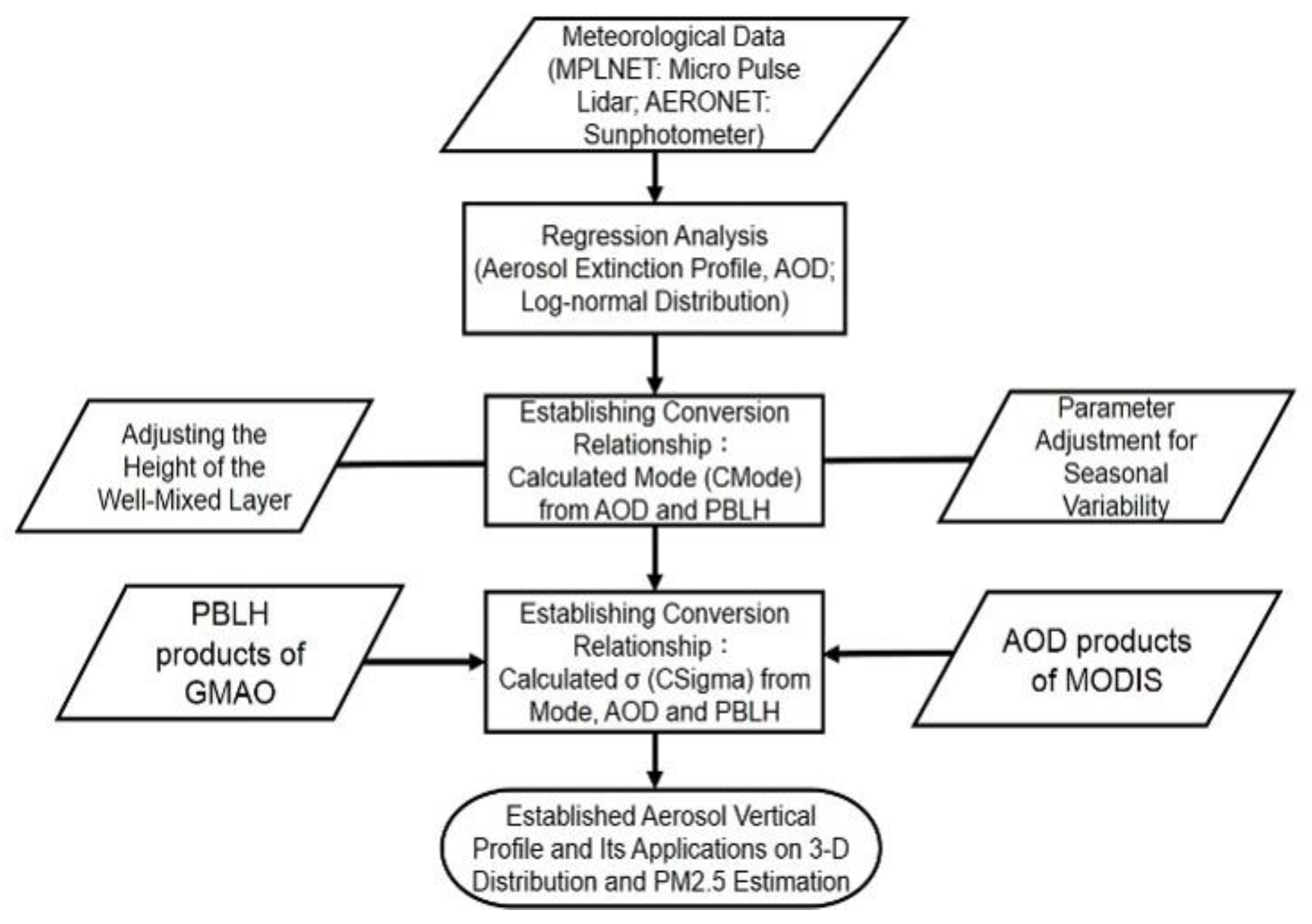


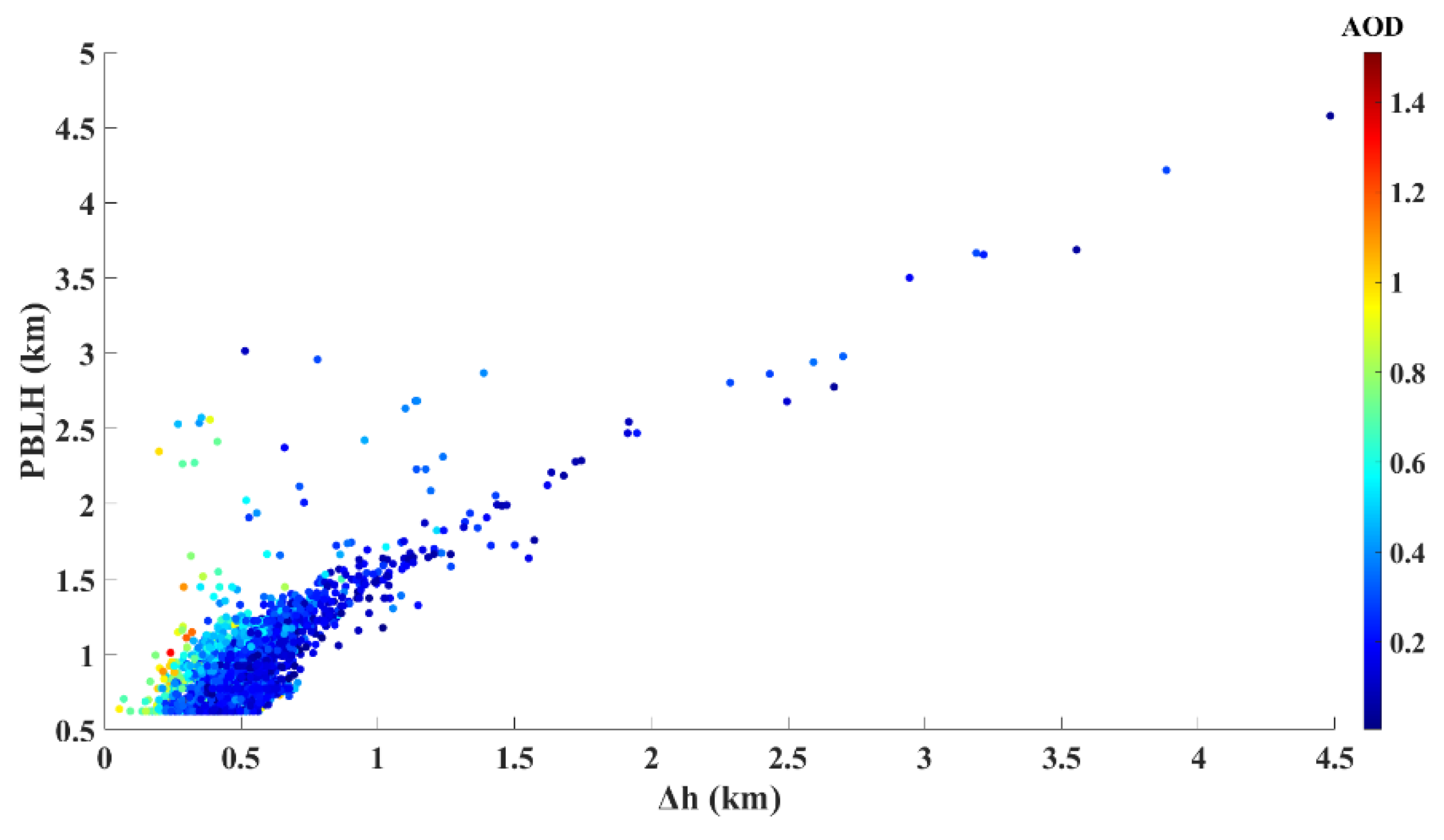
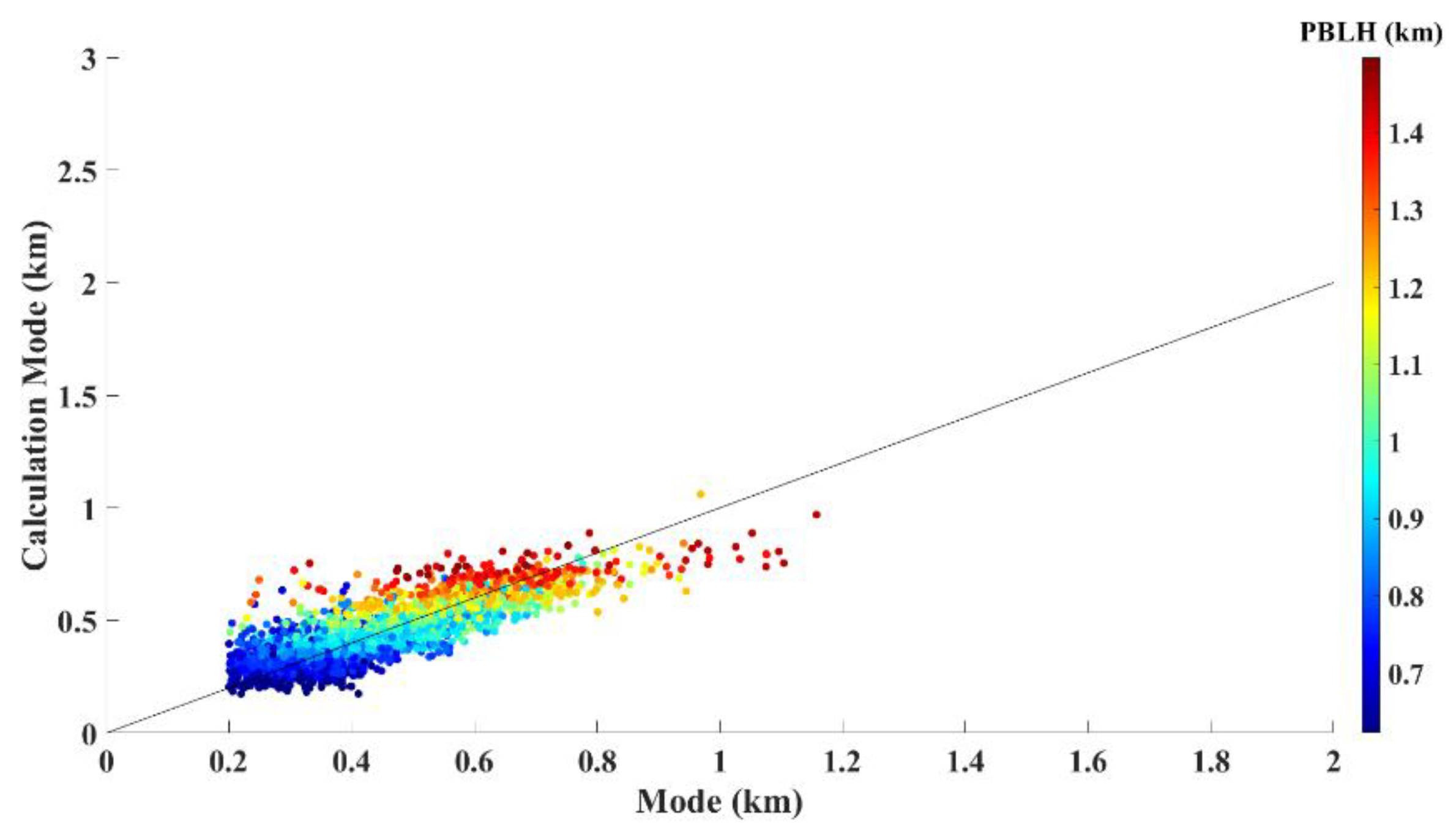
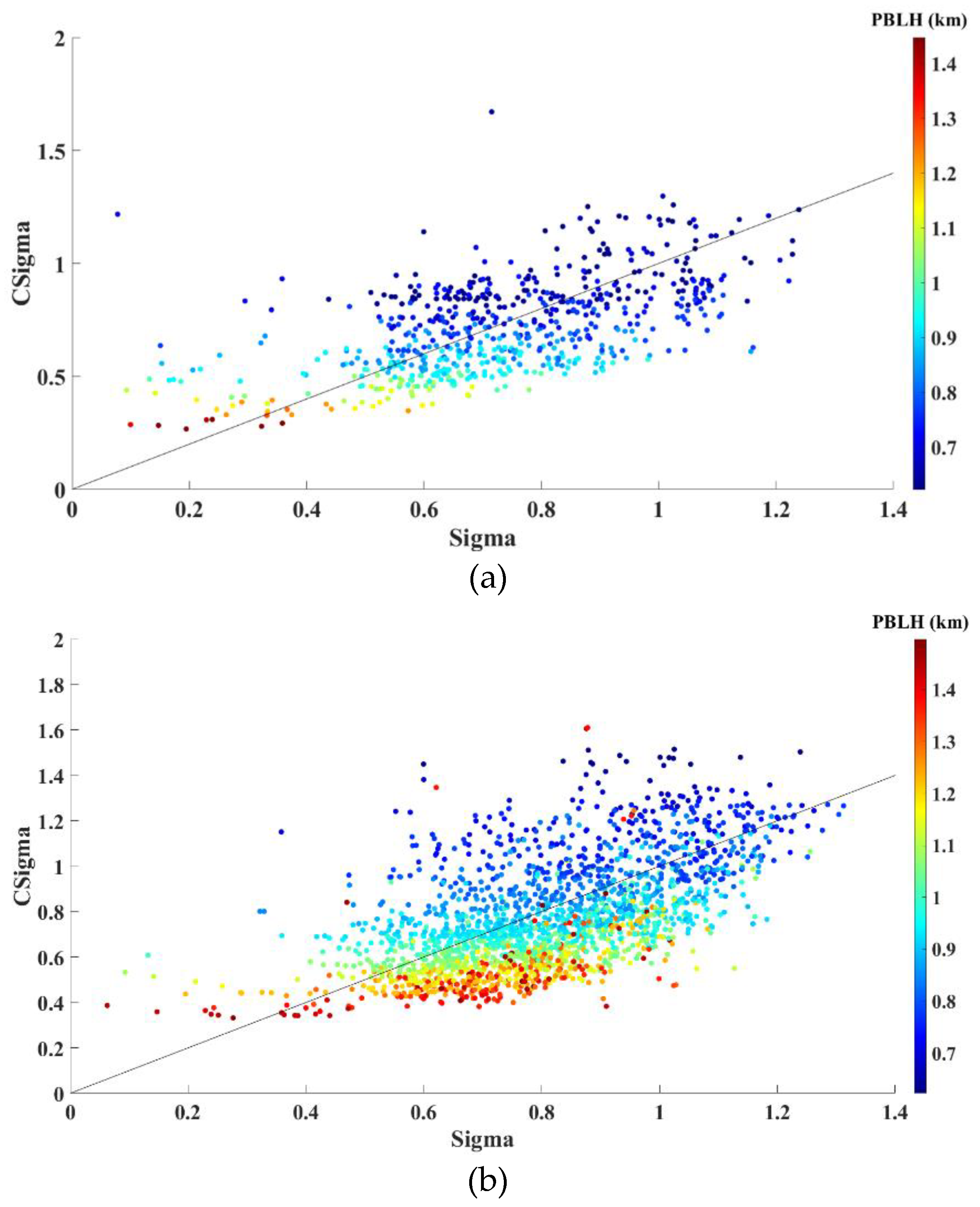
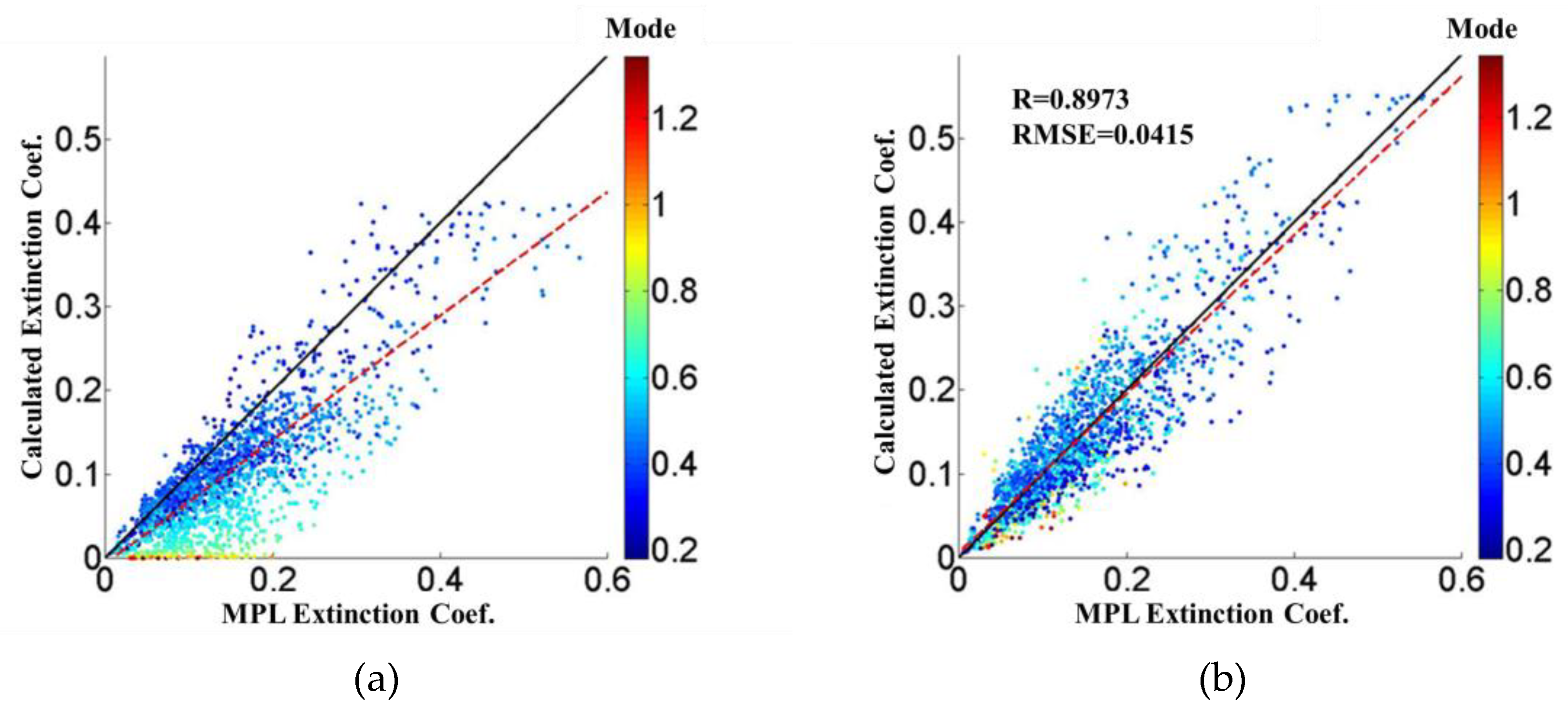
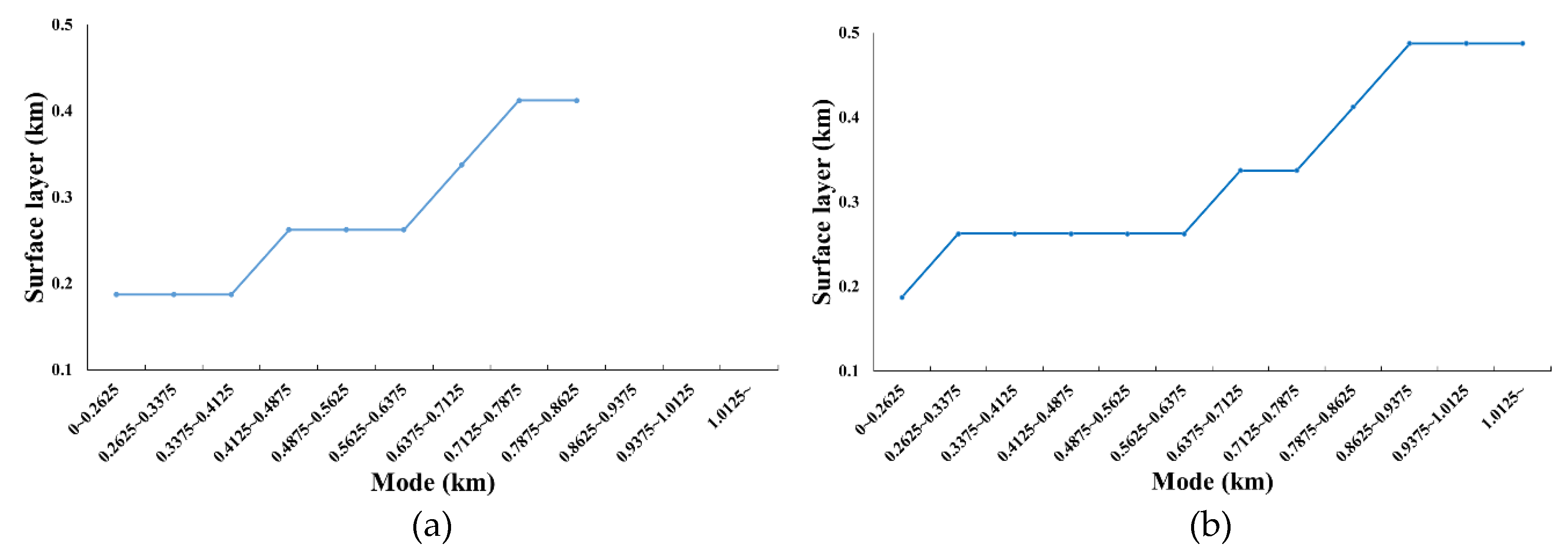


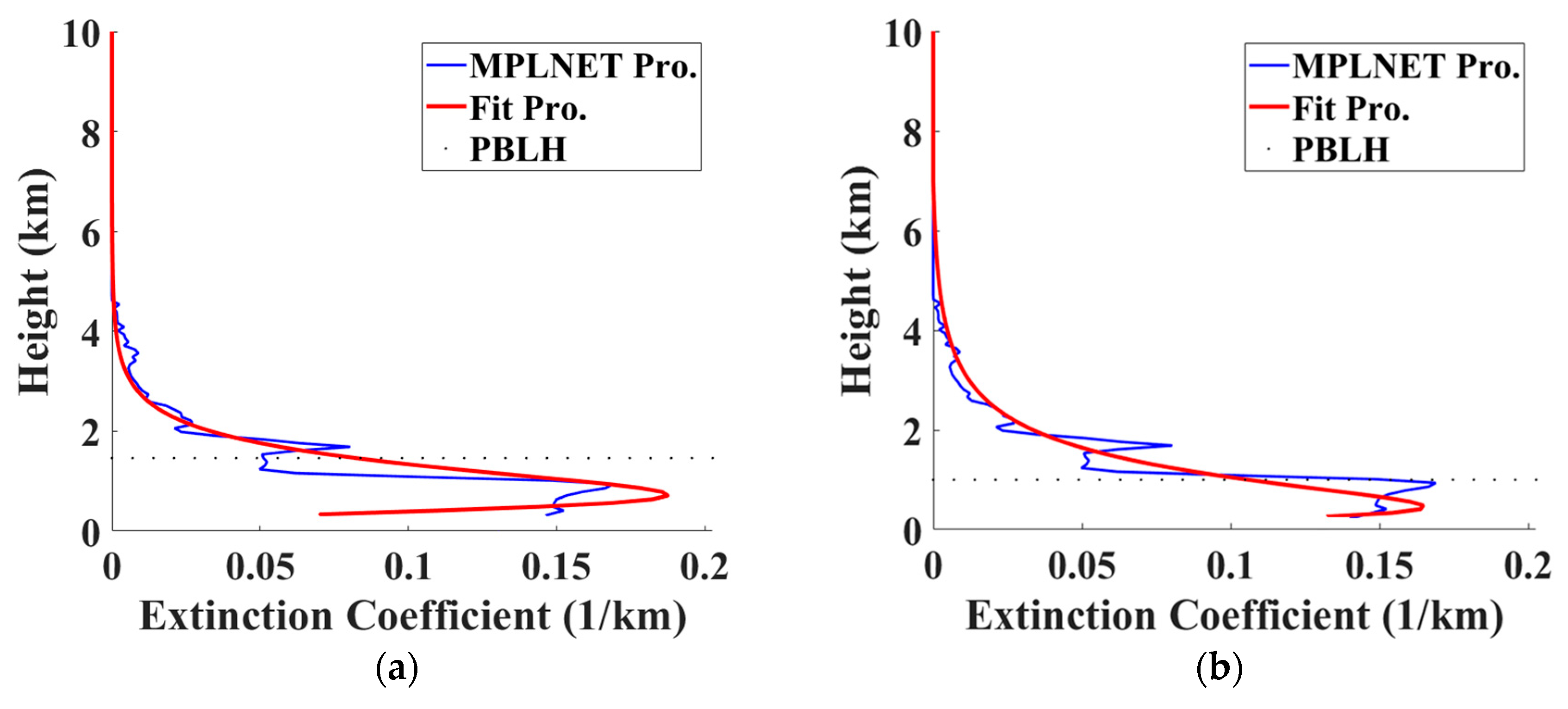
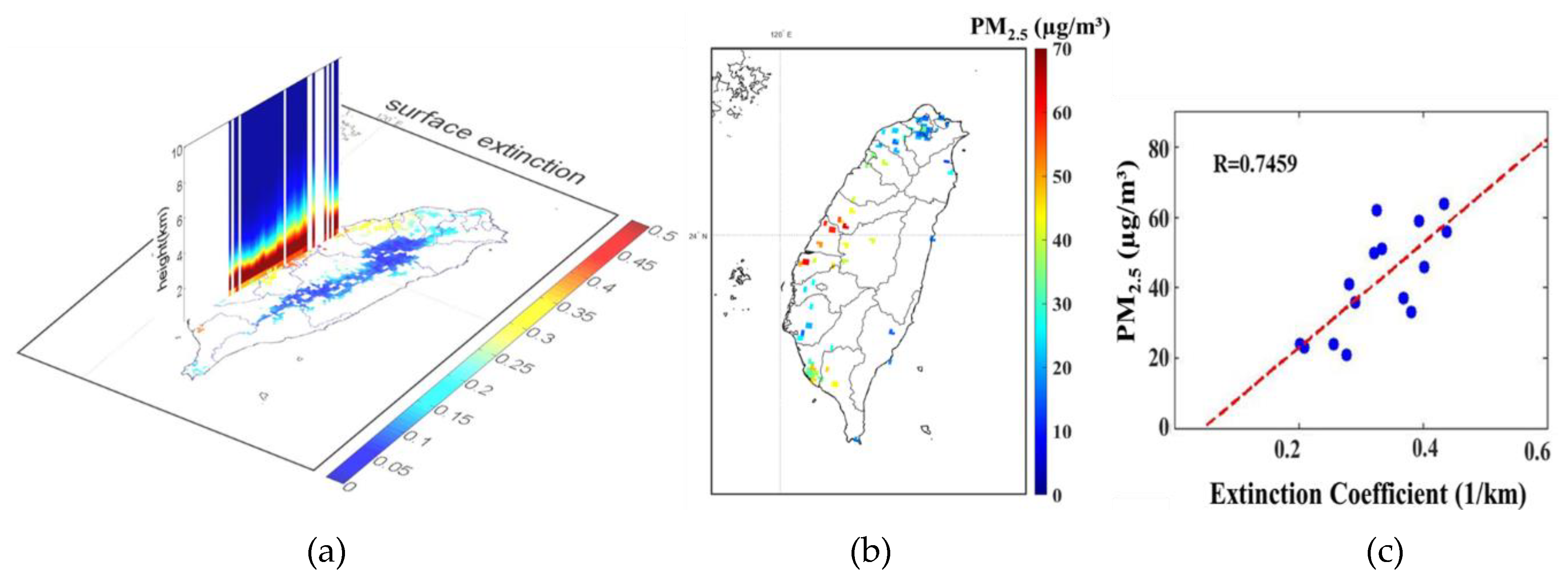
| AOD | Slope | Offset | R | RMSE | Data Point | Mean AOD | P-Value a |
|---|---|---|---|---|---|---|---|
| 0.00–0.05 | 1.037 | 0.3154 | 0.9984 | 0.1044 | 84 | 0.025 | <0.001 |
| 0.05–0.10 | 1.191 | 0.2303 | 0.9935 | 0.0334 | 286 | 0.075 | <0.001 |
| 0.10–0.15 | 1.110 | 0.2954 | 0.8217 | 0.1344 | 561 | 0.125 | <0.001 |
| 0.15–0.20 | 1.163 | 0.2762 | 0.9951 | 0.0232 | 594 | 0.175 | <0.001 |
| 0.20–0.25 | 1.163 | 0.3081 | 0.6815 | 0.1527 | 498 | 0.225 | <0.001 |
| 0.25–0.30 | 1.038 | 0.4288 | 0.9967 | 0.0246 | 343 | 0.275 | <0.001 |
| 0.30–0.35 | 1.279 | 0.3291 | 0.9908 | 0.0283 | 225 | 0.325 | <0.001 |
| 0.35–0.40 | 1.300 | 0.3376 | 0.9924 | 0.0361 | 180 | 0.375 | <0.001 |
| 0.40–0.45 | 1.139 | 0.4237 | 0.9796 | 0.0435 | 156 | 0.425 | <0.001 |
| 0.45–0.50 | 1.219 | 0.4372 | 0.9722 | 0.0452 | 136 | 0.475 | <0.001 |
| 0.50–0.55 | 1.137 | 0.4403 | 0.9736 | 0.0394 | 115 | 0.525 | <0.001 |
| 0.55–0.60 | 1.182 | 0.4554 | 0.9641 | 0.0531 | 70 | 0.575 | <0.001 |
| Δh | Slope | Offset | R | P-Value a |
|---|---|---|---|---|
| 0.00–0.20 | 17.115 | 1.3 | 0.756 | <0.001 |
| 0.20–0.25 | 13.863 | 1.3 | 0.840 | <0.001 |
| 0.25–0.30 | 11.251 | 1.3 | 0.792 | <0.001 |
| 0.30–0.35 | 9.7043 | 1.3 | 0.750 | <0.001 |
| 0.35–0.40 | 8.6445 | 1.3 | 0.684 | <0.001 |
| AOD | Slope | Offset | R | P-Value a |
|---|---|---|---|---|
| 0.30–0.35 | 8.277 | 2.5 | 0.2014 | <0.001 |
| 0.35–0.40 | 7.124 | 2.5 | 0.7593 | <0.001 |
| 0.40–0.45 | 6.148 | 2.5 | 0.8747 | <0.001 |
| 0.45–0.50 | 5.584 | 2.5 | 0.9064 | <0.001 |
| 0.50–0.55 | 5.486 | 2.5 | 0.9167 | <0.001 |
| 0.55–0.60 | 5.412 | 2.5 | 0.8908 | <0.001 |
| 0.60–0.65 | 4.336 | 2.5 | 0.933 | <0.001 |
| 0.65–0.70 | 4.129 | 2.5 | 0.9205 | <0.001 |
| 0.70–0.75 | 3.687 | 2.5 | 0.9673 | <0.001 |
| 0.75–0.80 | 3.590 | 2.5 | 0.9533 | <0.001 |
| 0.80–0.85 | 3.180 | 2.5 | 0.9818 | <0.001 |
| 0.85–0.90 | 2.954 | 2.5 | 0.9910 | <0.001 |
| 0.90–0.95 | 3.191 | 2.5 | 0.9671 | <0.001 |
| >0.95 | 3.425 | 2.5 | 0.6446 | <0.001 |
© 2020 by the authors. Licensee MDPI, Basel, Switzerland. This article is an open access article distributed under the terms and conditions of the Creative Commons Attribution (CC BY) license (http://creativecommons.org/licenses/by/4.0/).
Share and Cite
Lin, T.-H.; Chang, K.-E.; Chan, H.-P.; Hsiao, T.-C.; Lin, N.-H.; Chuang, M.-T.; Yeh, H.-Y. Potential Approach for Single-Peak Extinction Fitting of Aerosol Profiles Based on In Situ Measurements for the Improvement of Surface PM2.5 Retrieval from Satellite AOD Product. Remote Sens. 2020, 12, 2174. https://doi.org/10.3390/rs12132174
Lin T-H, Chang K-E, Chan H-P, Hsiao T-C, Lin N-H, Chuang M-T, Yeh H-Y. Potential Approach for Single-Peak Extinction Fitting of Aerosol Profiles Based on In Situ Measurements for the Improvement of Surface PM2.5 Retrieval from Satellite AOD Product. Remote Sensing. 2020; 12(13):2174. https://doi.org/10.3390/rs12132174
Chicago/Turabian StyleLin, Tang-Huang, Kuo-En Chang, Hai-Po Chan, Ta-Chih Hsiao, Neng-Huei Lin, Ming-Tung Chuang, and Hung-Yi Yeh. 2020. "Potential Approach for Single-Peak Extinction Fitting of Aerosol Profiles Based on In Situ Measurements for the Improvement of Surface PM2.5 Retrieval from Satellite AOD Product" Remote Sensing 12, no. 13: 2174. https://doi.org/10.3390/rs12132174
APA StyleLin, T.-H., Chang, K.-E., Chan, H.-P., Hsiao, T.-C., Lin, N.-H., Chuang, M.-T., & Yeh, H.-Y. (2020). Potential Approach for Single-Peak Extinction Fitting of Aerosol Profiles Based on In Situ Measurements for the Improvement of Surface PM2.5 Retrieval from Satellite AOD Product. Remote Sensing, 12(13), 2174. https://doi.org/10.3390/rs12132174









